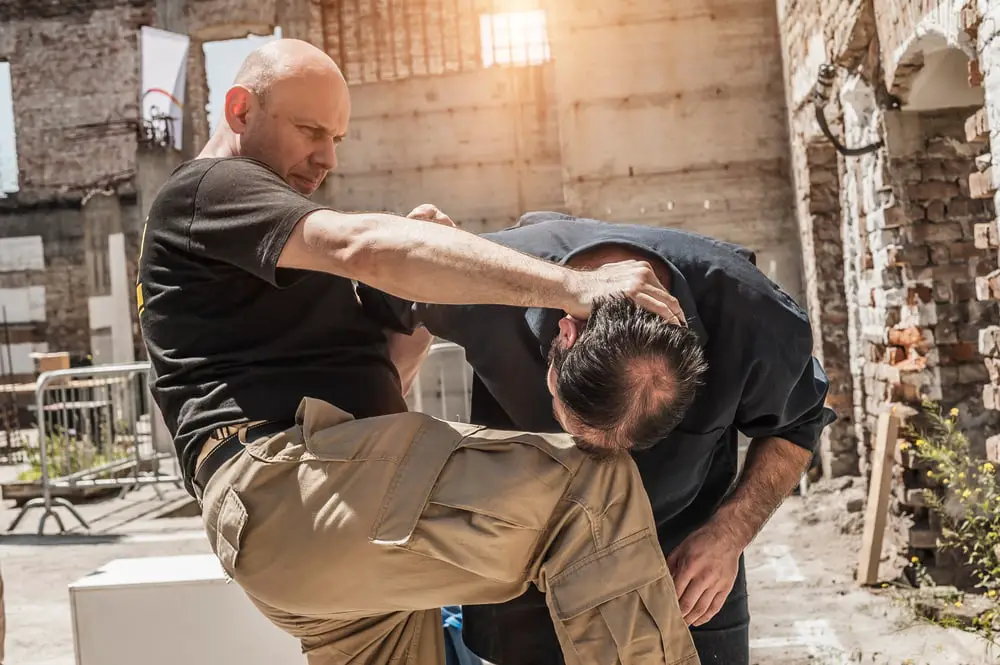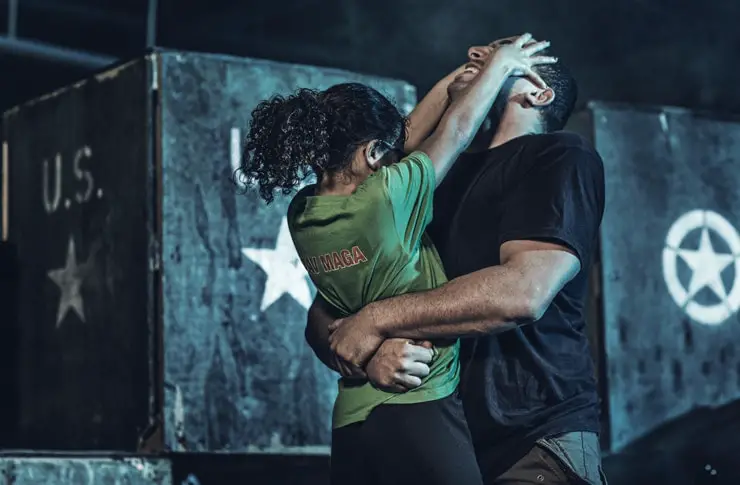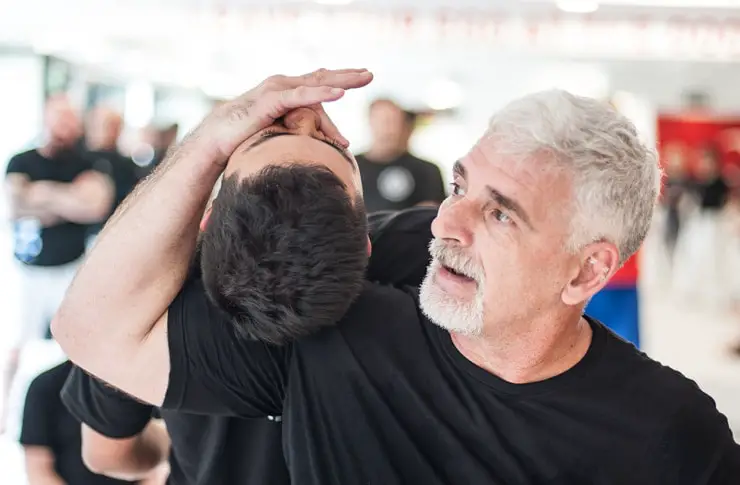In this article, we’re giving you all you need to know about Krav Maga – the self-defense and fighting system that was developed originally for the Israel Defense Force. We’ll start with the basics, then examine the principles and techniques before discussing examine why you should consider taking up Krav Maga.

Krav Maga History
Krav Maga, as mentioned above, is a self-defense and fighting method that was developed for the Israeli Defense Force and certain Israeli security forces.
Krav Maga’s creation is credited to Hungarian-Israeli martial artist ImiLichtenfeld. Lichtenfeld had experience as a boxer and a wrestler. During the late 1940s, Lichtenfeld gave combat training to a group that would eventually develop into the IDF. During this time, Lichtenfeld developed Krav Maga. He derived the system based on a combination of the most effective techniques from boxing, wrestling, karate, judo, and aikido. Krav Maga was meant to emphasize extreme efficiency while also being easily teachable to large groups of people.
Krav Maga has since been officially adapted by the IDF as well as other Israeli intelligence units and law enforcement units. Krav Maga has also developed popularity as a civilian martial art, with several organizations teaching variations of Krav Maga worldwide.
Now that we have a grasp of the history of Krav Maga, let’s check out its foundational principles:
Principles of Krav Maga
There is one primary principle of Krav Maga from which other principles derive – keep yourself safe. This is the primary goal of Krav Maga, although it is far from the only principle.
The No. 1 emphasis for a student of Krav Maga is to avoid physical confrontation. Krav Maga primarily emphases awareness of one’s surroundings, to detect and avoid dangerous situations, and to de-escalate situations when it is possible. Krav Maga emphasizes keeping your eyes and ears open, and that you never escalate a situation – you only react if necessary. Krav Maga emphasizes that you continue to build your awareness so that you become better at detecting these situations.

However, if you are unable to avoid a confrontation, then Krav Maga provides the tools for fighting back. Fighting is the last resort, but if a fight is unavoidable, then the fight is guided by the following principles:
- Weak Points: Krav Maga teaches students to aim for an opponent’s weak points. Weak points are generally considered the parts of the body which can’t develop muscle. As a result, they are more susceptible to damage and can be more quickly overpowered. Since Krav Maga is meant as a last resort, and primarily to defend oneself against imminent threats, there are no rules except to do what is most efficient. The universal weak points of the body include your nose, throat, eyes, groin, and face.
- Speed and Efficiency: Krav Maga’s offensive techniques are based around speed and efficiency. Krav Maga teaches instantaneous responses, with attacks that generate the most power in the least amount of time. These are efficient attacks for defending yourself in an unexpected situation. These attacks can be performed quickly, which makes them easier to apply in real-life situations. They can be more readily committed to muscle memory.
- Size Doesn’t Matter: Of course, this isn’t completely true, but Krav Maga does teach that you can defend yourself no matter your size. If you have efficient technique and you know where to strike, then a person of any size can be successful in a fight.
- Reacting Under Stress in Real-world Situations: Krav Maga heavily emphasizes the mental side of self-defense. It trains you in a variety of real-world situations so that these situations won’t be as large a surprise if you encounter them in the real world. By training to adapt to these real-life situations, you can quickly assess them and react accordingly.
- Repetition:Krav Maga teaches students based on repetition. Essentially, you repeat situations and techniques over and over until they are built into your muscle memory. Krav Maga teaches your mind and body to know how to react when you encounter a threatening situation, because there won’t always be time to assess.
- Don’t Fight More Than You Have To: Whenever possible, exiting the situation is a priority. Krav Maga teaches you to do whatever possible to protect yourself, and the best way to do that is to not be in a threatening situation. If the opponent de-escalates, or you have an opportunity to leave, you take it.
- Krav Maga is Adaptive:Krav Maga is all about adapting to real-world situations and doing whatever is in your power to respond to these situations. As a result, the martial art adapts as time goes on, and it is willing to accept any technique as long as it is efficient to teach and use. Krav Maga stays open to new ideas and adapts to new situations.
As you can see, Krav Maga is a versatile martial art with a focus on the real world. It’s not about combat, it’s about defending yourself when necessary. It’s about practical skills for reacting to threatening situations.
Why Krav Maga?

Now that we’ve outlined the basic principles and history of Krav Maga, we’ll get to the more practical advice. Why should you train Krav Maga? In the following sections, we’ll outline the basic practicalities and what you can expect from training Krav Maga.
Krav Maga has developed popularity as a civilian martial art because of its usefulness in real-world scenarios. Krav Maga training emphasizes real-life situations and trains students to know how to react when threatened. It is for people of all sizes and body types, and it can provide useful training to defend against any sort of attack.
For these reasons, it is a useful skill for just about anyone to learn. Classes are accessible and readily accepting of newcomers. Krav Maga is a welcoming community that emphasizes each others’ success.
Techniques
As mentioned throughout the article, Krav Maga is an adaptive martial art. As a result, it is everchanging, so it is impossible to sumup all the techniques you can expect to learn. Generally speaking, the common link is that all Krav Maga training will emphasize fast, effective movements.
Because Krav Maga draws inspiration from many different martial arts, you can expect to learn a wide variety of skills. It will focus on techniques that are efficient and most useful for utilizing in a real-world scenario.
Common categories of Krav Maga techniques include:
- Striking: Krav Maga teaches efficient striking, demonstrating its inspiration from boxing and karate. It also teaches students where to strike for maximum effectiveness.
- Takedowns: Krav Maga teaches takedowns, drawing inspiration from judo and wrestling. It also teaches students groundwork, although it emphasizes staying on your feet when possible.
- Escapes: Krav Maga teaches students to escape chokes and holds, as per judo and wrestling.
- Weapon Defense: Drawing inspiration from aikido, Krav Maga teaches students how to defend against someone with a weapon. It trains students to defend against threats from different kinds of weapons.
- And More: Krav Maga understands that real-world situations can’t always be grouped into categories. It trains students to defend against evolving threats, with the understanding that your attacker may not be bound by the limits and rules of martial arts.
How Does Training Work?

As a potential student of Krav Maga, you are likely wondering what you can expect. Krav Maga will differ depending on where you train because it is often overseen by different organizing bodies. Additionally, the teaching will depend on the teacher, the institute, and more.
That being said, there are some general similarities in how Krav Maga teachings are structured and organized for civilians.
Krav Maga teachings, like many martials arts, rank progressions based on the belt system. In Krav Maga, from lowest to highest, the belts are: white, yellow, orange, green, blue, brown, and black. In some areas, Krav Maga may be organized by a patch system instead of a belt system, with patches being grouped into practitioner, graduate, and expert.
The level of sparring and competition will differ depending on the institute where you are training. Because Krav Maga operates under the idea that you are defending yourself against an unwanted attack “by any means necessary,” it is not always useful (or safe) to simulate a fight between two Krav Maga students. As a result, much of the “sparring” is done by one student wearing protective gear and playing the role of the attacker while training the student to defend against various threats.
Is Krav Maga For You?
In this article, we’ve given you a comprehensive look at Krav Maga. Starting with its history, we also looked at the principles that guide its development and took a practical look at what you can expect as a student of Krav Maga.
Understanding Krav Maga is all about understanding its core principles and goals. Krav Maga is meant to train you for the worst-case scenario while also providing you with the tools to prevent that worst-case scenario from occurring.
Krav Maga gives you the tools to detect, deter, and prevent danger while preparing you for that danger should it become inevitable.
